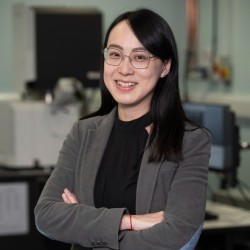Sustainable manufacture of photonic scintillators for next generation medical and discovery X-ray imaging detectors
A PhD study to develop sustainable manufacturing process to create novel photonic bandgap multilayer X-ray scintillator for X-ray imaging
Start date
1 January 2024Duration
3.5 yearsApplication deadline
Funding source
Sponsor (STFC) & University of Surrey Doctoral CollegeFunding information
£20,000 pa stipend and fees covered.
About
X-ray imaging detectors make use of X-ray scintillators to convert the X-rays, that have passed through the body or object, into visible light that can then be captured by a coupled digital imaging device to reveal the details of the internal structure. Currently, in order to achieve high resolution images requires the scintillator crystals to be shaped at a very fine scale which is time consuming, costly and produces a lot of waste. An alternative approach is to create a graded structure, consisting of alternating layers of scintillator and dielectric materials, to create a photonic bandgap material that is able to limit the spread of light within the scintillator such that high resolution images can be achieved without having to physically cut the scintillator. To date, the concept has only been demonstrated on materials less than 1mm x 1mm in size. A typical scintillator used in a commercial X-ray imaging detector would be at least 1,000 times larger.
This project is designed to assess the feasibility of creating large area multilayer photonic bandgap structures suitable for use as a next generation of commercial X-ray scintillator. Cerium doped Yttrium Aluminium Garnet [YAG(Ce)] will be used as the demonstrator material due to its wide spread use and known properties. This will be coupled with a suitable dielectric such as TiO2.
The project will involve the creation of multilayer structures using a print-based additive manufacturing approach and the subsequent identification of appropriate processing conditions required to yield a high density and self-supporting structure. The resultant structures will then be evaluated to assess their performance. The project will look to develop an understanding of the relationship between processing conditions and scintillator performance.
This project will form part of a wider collaboration involving STFC (the project sponsors), MIT and the University of Cambridge.
Eligibility criteria
Open to candidates who pay UK/home rate fees.
Candidates should have a background in materials processing and characterisation as demonstrated by relevant experience and/or degree in a related field such as materials science, chemistry, mechanical engineering or physics.
How to apply
Applications should be submitted via the Engineering Materials PhD programme page on the "Apply" tab. In place of a research proposal you should upload a document stating the title of the project that you wish to apply for and the name of the relevant supervisor.
Studentship FAQs
Read our studentship FAQs to find out more about applying and funding.
Application deadline
Contact details

Studentships at Surrey
We have a wide range of studentship opportunities available.

